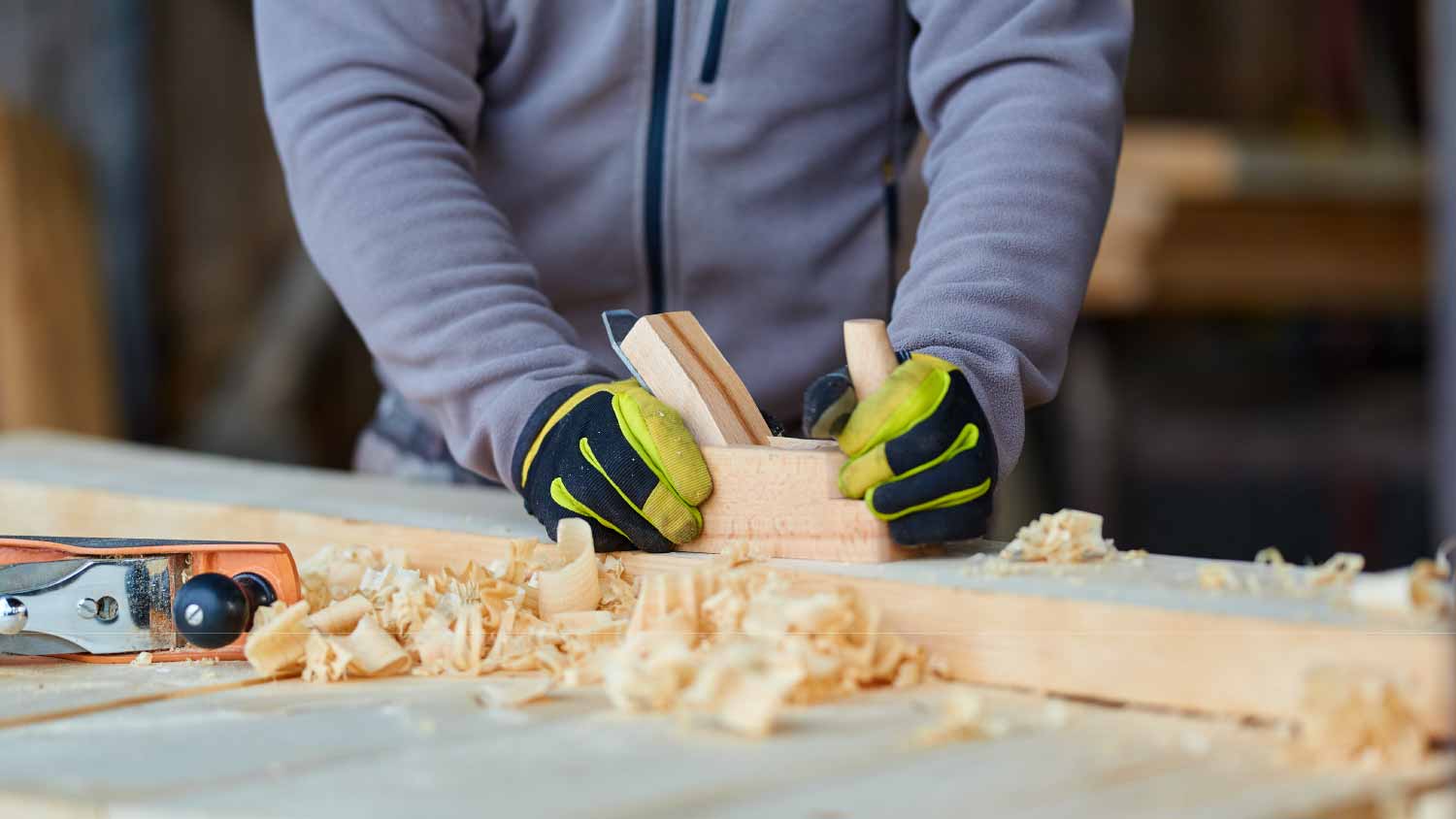
Discover the average professional organizer cost, what influences pricing, and how to budget for your next home organization project.
Don't assume this DIY is over your head just because it hangs from the ceiling


With limited wall and floor real estate available in the garage, creating DIY overhead storage for your garage is the perfect complementary project to building garage shelves. Not only can you maximize where you can store your seasonal items, but you save more room for turning the garage into a work or living space.
Keep in mind that hanging a shelf in a garage is an intermediate-level DIY project due to how much weight the shelf must hold. Only proceed on your own if you're confident with your carpentry skills.
There are several major types of overhead garage storage:
Sliding tote tracks
Plastic or metal pre-assembled overhead wracks
Wall-mounted shelving
Custom wooden overhead wracks
You can purchase the first three options at your local hardware store or online. These prefabricated kits provide pre-cut materials and all the hardware necessary to attach the storage system directly to the wall or ceiling.
However, for ultimate customization, you may wish to build the shelves from scratch. The instructions below review how to build custom wood overhead storage from wood. You will still need to purchase or create your own plans before starting.
Once you've purchased, downloaded, or written up your shelving plan, cut and mark each piece of wood before beginning construction. Check and double-check your measurements and markings before making any cuts or assembling the shelf.
While the size of your overhead storage shelf will vary, many designs are:
Length: 6–8 feet
Depth: 4 feet
Height: 1–1½ feet
When the shelf only hangs down one or two feet, it is less likely to bump the top of a vehicle or your head.

Let's get to know the major components of your overhead garage shelf cut list. Again, the exact measurements will depend on your design, but understanding the critical structural elements will ensure a sturdy plan.
Keep in mind that for stability, most DIY hanging shelves in a garage will use both the ceiling and the wall for support, placing the overhead storage up against the side of the room.
Joists: A joist is any horizontal framing beam. In your overhead storage shelf, you typically have one 2x4 front joist, two outer joists, and several support joists.
Ledger board: The 2x4 ledger board connects directly to the wall perpendicular to your ceiling cleat and offers key structural support.
Ceiling cleat: The ceiling cleat is a 2x4 board that connects directly to the ceiling and is an additional support structure for attaching your hanger boards.
Hanger boards: These 2x4 boards hang down from the ceiling cleat and attach to your joists.
Floor plywood: The plywood provides a base on top of your joists for storing items.
Before installing your garage storage racks, you’ll need to measure the space where you will be placing them. Since you will be relying on both the ceiling and the wall for necessary support, measure both areas. Make sure to note any obstacles that might block the racks, such as lights or garage door openers. Finally, confirm how deep you want the storage to be (which also translates to the height off the ground)—you’ll want to make sure there is clearance for any tall vehicles or objects, like ladders.
This is a critical step. You need to locate the wall and ceiling studs for installation—this helps ensure that the storage rack is safely and securely attached to the ceiling and can hold all your objects without breaking. To find the studs, you can use a stud finder or—if you’ve got a good ear—knock on the ceiling until you hear a solid sound, indicating there is a wooden stud there.
Mark the studs using a pencil. Each bracket of your storage rack will be aligned with at least two of the marked studs. The brackets should be installed across the width of your garage to ensure the strongest support possible for your new overhead garage storage.
Depending on the measurements and the location of your ceiling joists, you’ll need to cut the boards to length. Plywood is easily cut with a circular or table saw.
Now that you know where your studs are, you can secure your ledger board. Ideally with the help of a friend, place the pre-cut and measured ledger on the wall; ensure that the ledger board is plumb by measuring with your level. Hold and attach your ledger board to the wall by drilling screws through the wood and into the pre-marked studs.
Not that most instructions recommend adding a lag screw to each stud, too. A lag screw can hold heavier loads and is ideal for ledger boards and ceiling cleats. You will need a ratchet to attach the screws through a pre-drilled hole.
Like the ledger board, measure and mark the ceiling for the proper placement of the cleat. A chalk line or laser level can assist you when working overhead. Use the stud finder again to locate and mark the studs along your ceiling cleat line.
As before, attach the ceiling cleat according to your plan's instructions, using standard and lag screws in the pre-drilled holes at each joist.
One at a time, align each hanger board with the pre-marked spots where the hangers meet the ceiling cleat. Put the top of each hanger board against the ceiling and cleat and attach it with two standard screws—typically 2½ screws. Ensure each hanger board is plumb with your level before securing the second screw.
Add an L-angle to the inside of each hanger board to provide even more support between the ceiling cleats each hanger board.
Attach two joist hangers on either side of each spot where you will connect your interior joists, both on the ledger board and your front joist. While it will be relatively easy to add the joist hangers to the ledger board already anchored to the wall, it's best to add the joist hangers to your front joist back at your sawhorse for more stability.
Next, measure and attach the remaining L-angles to the inside of where the outer joists will meet the leger board and front joist.
Now that your front joist has all the connecting hardware in place, attach it to the inside of the bottom of the hanger boards, adding four screws in each corner to connect the joist. Between adding the hanger boards, double-check that the front joist is still plumb with your level and hasn't shifted
Slide your remaining joists—the ones that bridge the gap between your ledger and front joist—into the joist hangers and alongside the L-angles. Connect the joist hangers to the joist with specialized joist-hanger nails. Then, connect the outer joists to the L-angles with screws in each provided hole on the bracket.
Last but certainly not least: Slip the plywood on top of the joists and into the frame of your shelf. Mark the joists below the plywood with a chalk snap line and add a screw every 12 inches (or according to your plans) to connect the floor to the joists.
While the structure of a DIY overhead storage shelf is pretty intuitive, incorrect measurements can lead to a pretty dangerous setup. On the other hand, hiring a local carpenter or garage organization specialist is your best bet because it guarantees a successful, safe, and secure installation.
The cost of garage storage systems usually includes a rate of $50 to $75 an hour for installation, so assume you'll pay up to $150 for overhead storage installation. The price does not account for custom plans and specialized materials pros may offer.
From average costs to expert advice, get all the answers you need to get your job done.

Discover the average professional organizer cost, what influences pricing, and how to budget for your next home organization project.

These kitchen drawer organization tips will reduce time spent rifling through the kitchen looking for what you need. Learn how to organize your kitchen.

If your home is a bit messy, that’s perfectly normal. Trusting a professional home organizer to revamp your space can be worth the cost. Here’s how to find and hire a professional organizer.

Discover small closet organization tips to maximize space, reduce clutter, and create a stylish, functional storage area that suits your needs.

When was the last time you cleaned out your spice rack or linen closet? Our list of 12 things to get rid of in just one hour helps you toss what is old, expired, or no longer needed. Decluttering is faster and easier than you might think.

Maximize space and reduce clutter with these smart laundry room organization tips that boost function and even your home’s resale appeal.